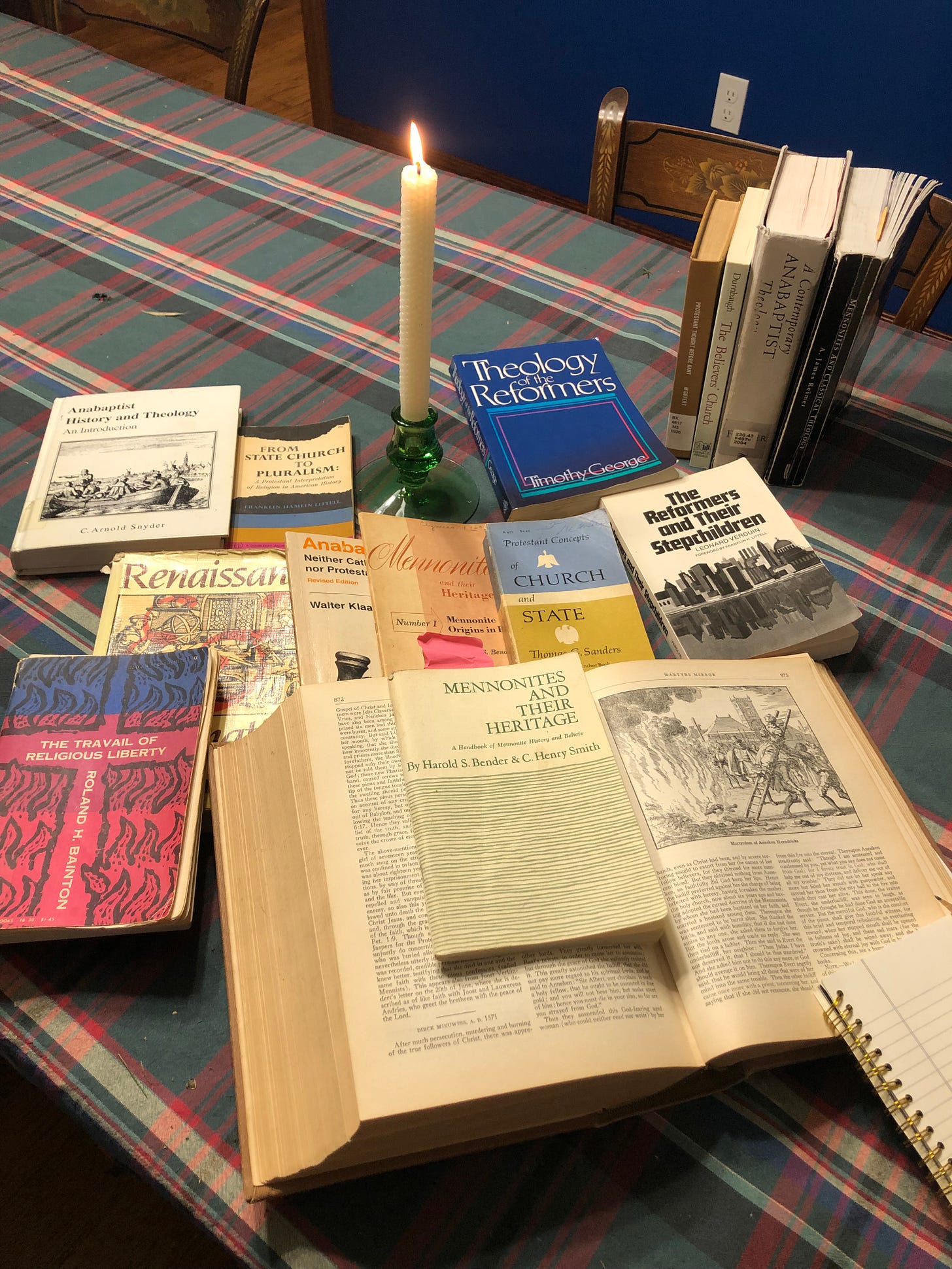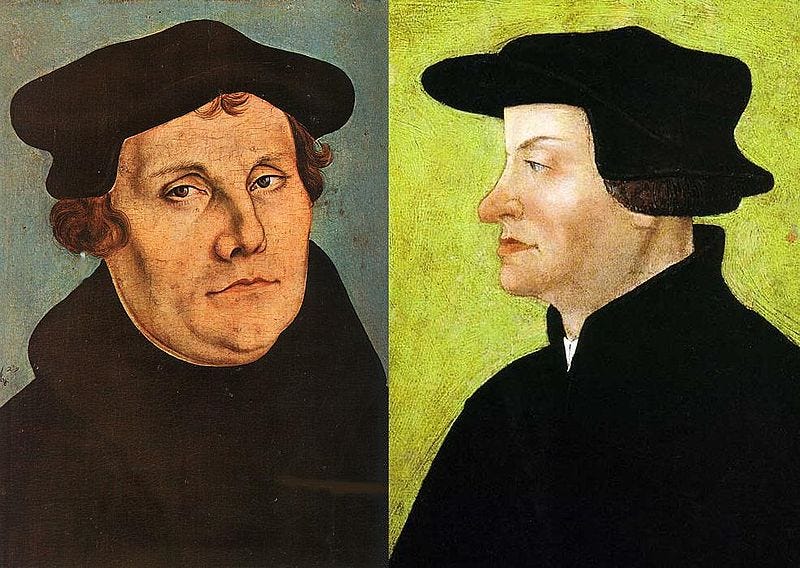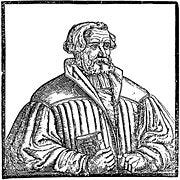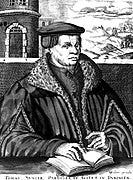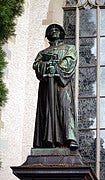"Judged by the reception it met at the hands of those in power, both in Church and State, equally in Roman Catholic and in Protestant countries, the Anabaptist movement was one of the most tragic in the history of Christianity; but, judged by the principles, which were put into play by the men who bore this reproachful nickname, it must be pronounced one of the most momentous and significant undertakings in man's eventful religious struggle after the truth. It gathered up the gains of earlier movements, it is the spiritual soil out of which all nonconformist sects have sprung, and it is the first plain announcement in modern history of a programme for a new type of Christian society which the modern world, especially in America and England, has been slowly realizing--an absolutely free and independent religious society, and a State in which every man counts as a man, and has his share in shaping both Church and State” (H. S. Bender quoting historian Rufus Jones in The Anabaptist Vision).
Introductory Summary:
In this post we hope to set the stage for what happened in Zurich January 21, 1525. We wish to first show some historical details, introducing some early radical reformers that preceded Anabaptism proper; we will then look at the town of Zurich and the leader Ulrich Zwingli. Third, we will briefly outline details in the three Zurich disputations from January 1523 to January 1525. Finally, we will trace how things unfolded, leading to that fateful evening of January 21, 1525 which marks the inception of the Anabaptist movement. In later posts we hope to outline events forward for around a decade as Anabaptist beliefs spread Northward to Waldshut, then toward South Germany and Austria. We wish to follow this history with our theme in mind: the development of the concept of free church and religious liberty as well as the question of how antecedent church traditions were both propelling and inhibiting the movement.
To begin with some historical pegs will help the reader.
Time Line of Events Before and After the First Rebaptism Meeting
1453: Fall of Constantinople: 1453
Late 1400s: Greek Texts come to Europe from Byzantine refugees
1516: Erasmus’ Greek New Testament published
1517: Luther’s 95 theses
1519: Zwingli’s Prophecy Meetings
1523: (Jan. 29) First Disputation in Zurich, Switzerland
1523 (October) 2nd Disputation in Zurich
1525 (Jan. 21) the first Rebaptisms in home of Felix Mantz
1525 (March) In Germany, Thomas Muentzer rallies his “eternal council” in an insurrection in league with the peasants; is executed by May.
1525 (Easter season) Balthasar Hubmaier was rebaptized by Wilhelm Reublin in Waldshut (only 20 miles north of Zurich).
1526 Michael Sattler (a previous Benedictine monk) emerges as a Swiss Brethren leader.
1527: (Jan 5) Felix Mantz is drowned for his faith in the river Limmat.
1527 The Schleitheim confession is developed.
1527 Anabaptism in South Germany emerges: Hans Hutt and Hans Denck (this is a more mystical variety).
1528 South German leader Pilgrim Marpeck works as a civil engineer and as leader in an Anabaptist congregation in Strasbourg.
1529 Melchoir Hoffman associates himself with the Anabaptist movement in Strasbourg. He is consumed with prophetic Scripture and dreams, moves to the Netherlands.
1535 Tragedy of Muenster
1536 Menno Simons joins the Anabaptists
Influence of Humanism
It would be hard to overemphasize that impact that classical studies had on the development of Reformation ideas. The Rennaissance opened up a wealth of information, but more particularly and more importantly was the role that its literary methods played in understanding texts and the history that formed them. Take for example the Rennaissance battle cry “Ad Fontes” (back to the sources"): this was referencing initially the classics of antiquity, but once those methods were applied to the Bible, conflict with traditional interpretation was sure to follow.
The Roman Church had developed a complicated and sophisticated method for interpreting and preserving church dogmatics. What was of particular importance was the way that these traditional teachings were preserved—through an absolute authority mostly unchallengeable. Consider what the Council of Trent has to say about any defection from its precepts. Though drafted after the Reformation, the conciliar decision asserts what was deeply imbibed within the Catholic structures of authority for hundreds of years:
'“Furthermore, in order to restrain petulant spirits, It decrees, that no one, relying on his own skill, shall,--in matters of faith, and of morals pertaining to the edification of Christian doctrine, --wresting the sacred Scripture to his own senses, presume to interpret the said sacred Scripture contrary to that sense which holy mother Church,--whose it is to judge of the true sense and interpretation of the holy Scriptures,--hath held and doth hold; or even contrary to the unanimous consent of the Fathers;”
But as the Reformers applied the principle of sola scriptura to the traditions of Rome they found some of the doctrines could no longer be defended. Hence Luther’s 95 theses and Zwingli’s disavowal of the Catholic view of the mass, etc.
But another question is essential here as it relates to interpretation and the role of humanism. How did Rome get so far off of the plain sense of Scripture, and then how did the Reformers dislodge those understanding themselves? What tools were they using that suddenly made them aware of these long-held errors? Why had Bible students not understood this before?
The humanism of Erasmus and other scholars of the late 15th and early 16th centuries was the driver of this change (note: this is not to be confused with the term secular humanism). With this humanism came a sounder hermeneutical method of studying ancient texts in their original languages and with that, the tools to study the Bible in Hebrew and Greek rather than only the Catholic's Latin Vulgate. This sparked the Reformation and then drove it to its revolutionary conclusions.1
Space will not permit us to detail much on Martin Luther, yet his influence and significance is unparalleled in the Reformation. But for our purposes two individuals that are significant in relationship to Luther bear mentioning. Andreas Karlstadt and Thomas Muntzer. Both of these men are considered radical reformers, but neither were exactly Anabaptists.
Karlstadt had taken leadership in the Lutheran reform when Luther was exiled to the castle at Wartburg after his refusal to recant at the famous Diet of Worms trial. Karlstadt moved toward enacting more sweeping reforms at a faster pace than Luther was comfortable with. On Christmas day 1521, in a packed church of around two thousand, Karlstadt was responsible for the new and reformed way of administering the communion. He abbreviated the Latin, eliminated the word “sacrifice,” and when the communion was offered to the laity, the priest spoke German. When Luther returned from his exile, he reinstituted a more moderate pragmatism with respect to the Reformation’s speed, reversing this novel communion practice back to the mass with some minor changes from the Roman one. His approach: “only after the word had convinced the weak [and the princes] should old customs and practices be changed.”2
Because of Karlstdt’s radicalism, he left Wittenburg and took up a pastorate in a parish of Orlamunde. Here he continued to push for more radical changes than Luther. Two components of his theology became evident, both of which had relation and influence on later Anabaptists. 1) He had little use for any extra-biblical tradition but sought to expunge all of it from the practice of the Church. The Anabaptist’s later would follow in this desire. 2) While he held to a literal reading of Scripture as did Luther, he emphasized the role of the Holy Spirit in interpreting it more than Luther. Karldtadt’s theology of Spirit here became very influential with the more mystical varieties of Anabaptism found in Hans Denck and Hans Hutt in South Germany.
The infamous Thomas Muntzer reveals a tragic and dark side to the Radical Reformation. He, like Karlstadt, is considered radical but not exactly an Anabaptist, though because of his several statements casting question on infant baptism, he is sometimes thought to be an Anabaptist. This is a handy way for those who have no use for the Anabaptists to quickly vilify the movement.
Muntzer was quick to associate the Reformation with the social economic condition of the German peasants. He quickly became a valiant supporter for their cause. He was not impressed with Luther’s moderation whom he could refer to as “Brother Fattened Swine” and “Brother Soft Life.” And Muntzer growingly accommodated to the idea of using the sword to accomplish his agenda for the social betterment of the masses. His vision for the future coincided with the peasant wars that had erupted in this period.
But the aspect of Muntzer’s theology that is most alarming is how he viewed spiritualism in the area of dreams and visions. For him the canon was not closed; God could speak directly to the individual (and especially to Thomas). This all dove-tailed with his extremely fanciful views of eschatology that led to the tragedy that came to climax in the spring of 1525.
Muntzer, and a great mass of peasants, assembled in mid-May to do battle against the godless. He was convinced God had called them (the righteous with the peasant’s cause) to slay those who held abusive power over them, then inherit the new kingdom. He wrote a letter just before this great battle insulting the Count Ernst of Mansfield referring to him as a “miserable bag of worms,” and signed the letter, “Thomas Muntzer with the Sword of Gideon.”
In the end, the peasants were decimated, five thousand were killed, and Muntzer was discovered hiding in an attic. He was beheaded on May 27, 1525.
We mention these two characters here because they will be referred to again and again throughout the Anabaptist movement, especially since they predate the first rebaptisms in Zurich (though, the actual date of Muntzer’s last battle occurred afterwards). Scholars discuss this with respect to the various movements that sprang up, not only in Zurich but also in South Germany, North Germany and eventually in Holland. The North German and Dutch Anabaptist movements were deeply influenced by Melchoir Hoffman, a spiritualist Anabaptist (similar to Muntzer in some ways) that nonetheless was too influential among the Dutch, as we will see in future posts.
Zwingli, Zurich, and the Prophecy Meetings
What we have said about humanism applies very directly to Ulrich Zwingli. He was a Catholic priest, who became disturbed over certain Roman Catholic practices and began to question their biblical validity. He knew Erasmus, and after he received a copy of his Greek New Testament, Zwingli devoured it. He learned Greek on his own; his successor Bullinger said of him that he had memorized in Greek all of the Pauline Epistles. He became rather obsessed with going to the Scriptures in Greek and receiving what they taught unfiltered by Catholic dogmas. He said as early as 1516 that “led by the Word and the Spirit of God, I saw the need to set aside all these human teachings and to learn the doctrine of God direct from his own Word.”3 He eventually became chief pastor at the well-known Grossmünster of Zurich. In 1519, he began the revolutionary practice of abandoning the lectionary and preaching directly from the gospel of Matthew, picking up after each sermon where he’d left off. By 1525, he had preached through most of the New Testament and then went to the Old.
This process of moving away from the Romish practices led eventually to what some scholars perceive as a methodical strategy for reformation. The preaching was first and perhaps foremost one such method. But another is revealed in his mentoring. As early as 1519, he assembled around twelve young scholars to study together. Zwingli came at the Reformation more through humanist studies rather than the monastery- driven struggle of conscience as had Luther. He gathered these scholars together and they studied Latin, Greek and Hebrew. Several of these young men had already achieved a measure of education from European universities, but they were interested in getting first to the classics and studying them with the new humanist methods. This then led to their study of Scripture where they developed a pattern together that is worthy of note. They would read the text in Latin, then examine it in Greek, and by 1522 they had acquired an adequate understanding of Hebrew to study the Old Testament as well. They would study the “glosses” (definitions of words) and the scholia (interpretations) and arrive at a consensus as to what the text meant. Finally, one in the group would develop a sermon in the Swiss dialect from their freshly studied text. Among those in the group, two stand out: Conrad Grebel grew in his expertise of Greek, and Felix Manz excelled in Hebrew. This final process points toward the later development of a written translation of the Scripture in the Swiss dialect that would come together later in the famous Froschauer Bible, a favorite of the Anabaptists.
Disputations
But Zwingli’s fresh start approach of going to the word of God alone would take his young scholars further than he originally anticipated. Several in the group began to develop ideas that, though first originated within the orbit of Zwingli’s approval and approach, he grew increasingly wary of. Zwingli had questioned the validity and place for infant baptism but came to realize that to do away with it would take the institution of the church on a route that would remove it from the aegis of State influence and protection. And Zwingli was beholden to the Zurich Council for his position and influence. After he resigned from the priesthood, married and began his reforms, the Council assured him of his position as the head of the Grossmünster. He became a state-backed reformer. Now some of his proteges were threatening the alliance he held with this Two Hundred Man Council.
This internal division of these students was not brought to light in the first Disputation in 1523. Here, Zwingli merely established the basis for his Reformation approach vis-a-vis the Catholic teachings that he had come to repudiate. Zwingli wrote up 67 articles at this disputation that refuted the Catholic notions of the papacy, purgatory, vestments, celibacy of the priesthood, and the mass.
It was at the second disputation in October of 1523 when the rift publicly occurred. Here around 800 men convened, 350- 500 of which were priests and monks. Though this public disputation intended to discuss three areas: images, the mass and purgatory, it was the second area, the mass, that consumed the attention of the debaters. After the second day of disputation the conclusion was clear: the mass as taught and practiced by Catholicism was abominable and idolatrous and held no New Testament merit. When the Burgermeister sought to adjourn for the day, several among Zwingli’s coterie of young scholars were impatient that nothing was decided as to what should now take place in light of this understanding. Would it now be abolished and a simple New Testament approach to Communion be practiced? It is recorded that Conrad Grebel first asked this question.
What follows here is a famous exchange that is quoted in numerous sources. This discourse represents the main issue in view within the soon to be Anabaptist movement.
To this question asked by Grebel, Zwingli replied: “My Lords [the Zurich Council] will decide what measures are to be taken from this point on regarding changes in the mass.” Simon Stumph, a priest and another of the young scholars, interjected:
“Master Ulrich, this power is not in your hands to turn over to my Lords . . . for that decision is already made: the Spirit of God judges. So, if my Lords arrive at some other decision and judgment that is against the judgment of God, I will ask Christ for his Spirit and will teach and act against it.”
This response by Stumph reveals what is the main issue in Anabaptism as it came to develop—that is the role of the State with respect to the Church. Stumph was stating a basic New Testament fact that the Spirit and the Word of God decide the practice of the Church not some civil council that will only put into place what is expedient for its welfare. Zwingli’s response to Stumph is interesting and reveals what will follow in the succeeding Reformation history.
To Stumph’s statement Zwingli said:
“That is right. I will also preach and act against it, if they render another decision. I do not deliver that decision into their hand. They are not to sit in judgment of God’s Word and that goes not only for them but also for the whole world.”
So Zwingli first accepts this correction, but then he adds:
“Also this assembly is not to decide what they should do but to determine in light of Scripture whether the mass is a sacrifice for sins or not. So, later on the members of the council will determine what measures will be taken concerning these matters.”
Zwingli was saying that those gathered for this 2nd disputation were there to make deliberations about what is the true teaching of Scripture, but then subsequently, the Council (the State) will decide how and when to effect any changes. This was unsatisfactory for those who were convinced that what was presently being practiced was erroneous, and needed to be changed now, not in some vague time frame prescribed by the State Council.
This is the signature issue that underlies the Anabaptist movement. The 2nd disputation lasted 3 days. On the third day, Grebel revealed his displeasure more overtly and for a significant period of time debated Zwingli on the matter of the mass. Toward the end of the disputation and the following weeks and months the separation became more and more apparent. William Estep says “in the eyes of Grebel and his friends the authority of the Word of God had been sacrificed upon the alter of human expediency. The youthful disciples felt they had been betrayed.”4
H. S. Bender has stated his conviction that this was a pivotal moment in history where the free-church movement had sprung into an incipient motion.
“The decision of Conrad Grebel to refuse to accept the jurisdiction of the Zurich Council over the Zurich church is one of the high moments of history, for however obscure it was, it marked the beginning of the modern free church movement.”5
The Third Disputation and the First Rebaptisms
Afte the 2nd disputation and into the early part of 1524, Grebel and Manz attempted to rally the Zwinglian church toward more thorough and immediate reform. Zwingli and those who were with him resisted this in favor of a steadier and more compromised method. Feelings began to fester and by September the parting of ways was inevitable. Other issues came to the fore: not just the mass but the relationship of the Church to the State, and the problem of pedobaptism.
Infant Baptism is linked inextricably to State Church. For Zwingli and Luther, though both had looked on it with deep question, they could not break with the practice due to its association with that which both Reformers became attached: a state-oriented church in which civil society was held together by virtue of a common religion. Infant baptism was the glue that allowed this to work. It went back to the time at least as early as Constantine. And succeeding nations and empires ever since have sought to use this as a unifying framework for a civil structure to unify its society and function seamlessly. All those born in a community are included, without their consent, as part of the Corpus Christendom. And they are not free to live there and resist anything that the society deems is essential in matters of state or religion.
Zwingli held power, and his power and position was entangled with that of the Zurich Council. So, when his young proteges pushed the boundaries of his reform, and in the fall of 1524, sought to establish a church with voluntary only membership, he and his associates took a decisive approach to end what he began to see was a rebellion. A final 3rd disputation was arranged on Jan 17, 1525. Here the debate centered on baptism. Though Manz, Grebel, and Blaurock argued fiercely, they were met with fierce resistance by Zwingli and his town council. Two state-backed mandates followed—one on the 17th and another on the 21st.
dissenters were commanded to cease meeting; in addition, they were required to have their children baptized (Grebel had not as of yet baptized his own infant daughter and resisted doing so). If they refused, they would have eight days to leave the canton.
noncitizens were listed and told to leave the canton in 8 days. (two of these were Wilhelm Reublen, a pastor from Wytikon who would later become deeply involved in the early Anabaptist movement, and Johannes Brotli, a retired priest from Zolikon who had earlier pushed hard against infant baptism there).
So, the background of the decision to secretly meet and be rebaptized on the evening of Jan 21 occurred after all of this precedent. The young Radical Reformers were ostracized and would have to decide between violating conscience and banishment. They considered their former mentor a halfway man, concerned only with keeping stability and preserving what the State would cooperate with. So much for the earnest desire to be entirely obedient to the fresh exegesis of the Holy Scriptures. In this kind of quandary, they met at the home of Felix Manz within sight of the Grossmunster and there it was first George Blaurock who asked Conrad Grebel to rebaptize him. The event is recorded in The Large Chronicle of the Hutterian Bretheren,
“And it came to pass that they were together until anxiety came upon them, yes, they were so pressed in their hearts. Thereupon they began to bow their knees to the Most High God in heaven and called upon him as the Informer of Hearts, and they prayed that he would give to them his divine will and that he would show his mercy unto them. For flesh and blood and human forwardness did not drive them, since they well knew what they would have to suffer on account of it.
After the prayer, George of the House of Jacob stood up and besought Conrad Grebel for God's sake to baptize him with the true Christian baptism upon his faith and knowledge. And when he knelt down with such a request and desire, Conrad baptized him, since at that time there was no ordained minister to perform such work.”
After this Blaurock baptized all the others present, probably around a dozen men. They then covenanted together to live as disciples of Christ, separate from the world and to hold and teach faithfully the gospel. Here Anabaptism was set in motion. Estep says of this event:
“Although it may not have been evident at the time, this was the most revolutionary act of the Reformation. No other event so completely symbolized the break with Rome and the medieval sacral society. For the first time in the course of the Reformation, a group of Christians dared, without the support or approval of the Magistrates, to form a church modeled after what they believed was the New Testament prototype. By doing so, they affirmed the absolute Lordship of Christ and the voluntary nature of the personal commitment to him. This act was an obvious refutation of the church’s concept of baptism and at the same time a rejection of the authority of the state in religious matters.”
Two Legacies
The picture above is Zwingli before the Wasserkirche (Water Church) in Zurich just by the Limmat river. Though unclear here, he stands with a bible in one hand and a sword in the other, representing his use of the State in its military and coercive power to defend, coerce, and even expand the borders of his reformed canton. As the battles between the Reformed and Catholic districts of Switzerland, Austria, and Germany raged, by the late 1520s the Reformed areas were expanding and Zwingli thought he and other Reformers were closing in on a more complete regional success. With this conviction he strove harder to annex against the Catholics. Of course, this required violence. In 1531, he went out with his Zurich troops fully clad in armor and wielding a double-edged sword. Late in the evening of October 11, he was knocked from his horse and run through with a sword. When the Catholics found him, they decapitated him, put his head on a pole, quartered, then burned his body, mixed the ashes with pig dung and scattered them over the countryside.
Though Zwingli left a mighty legacy, his leadership taken up by Bullinger and others extending down to today, he died as Jesus said: “they that take up the sword shall perish with it.” His Anabaptist stepchildren (as Leonard Verduin calls them) continued on, they too dying but doing so for the cause of Christ not the canton—drowned, tortured, burned, executed by the thousands because they refused to implement the methods of the Church of Jesus Christ with the State, its forced infant baptisms, its physical coercion and violence. The latter is the legacy left to us.
Coming Next:
We will break from this series with an article by Anthony Sanchez on a very important theological subject!
.
This method is often called the Historical Grammatical Exegetical method. This is a subject for a post itself. But in short, it looks at texts with a basic literary interpretive style that studies them in their historical context and searches out the author’s intentions through grammatical exegesis rather than through the filters of Tradition.
cited from C. Arnold Snyder, Anabaptist History and Theology.
quoted from Timothy George, Theology of the Reformers.
William Estep, Rennaissance and Reformation.
H. S. Bender, Conrad Grebel.


